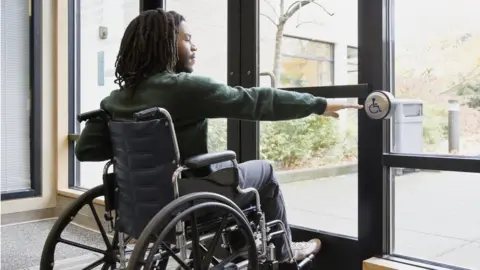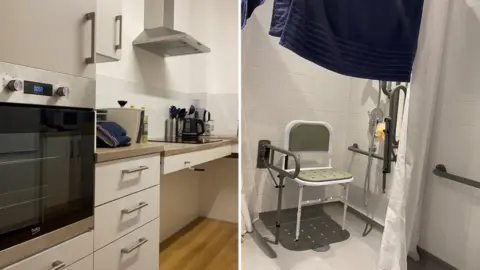Revealed: Major cities failing to plan for any wheelchair accessible homes
 Getty Images
Getty ImagesSome of England's major cities have no plans for providing wheelchair-accessible homes, the BBC has found.
Three of the 10 largest cities have no requirements beyond the national guidelines, which only say homes should allow wheelchair users through doors and hallways on the entrance level.
Disabled people say they face long housing searches, huge extra costs and poor homes which harm their health.
The government said it intends to strengthen the national standards.
The failure to plan for fully accessible homes was uncovered by BBC Freedom of Information requests to hundreds of local councils, underscoring what the Equality and Human Rights Commission has called a "hidden crisis" in housing for disabled people.
Local councils can require housebuilders to ensure a percentage of homes meet higher standards of accessibility, ensuring that bathrooms and kitchens are usable and that all rooms offer enough space for wheelchair users to move around.
But the FOI responses revealed cities such as Sheffield, Coventry and Bradford currently have no quotas. After the FOI request, Coventry introduced an "optional requirement" which applies to some affordable homes.
As the number of disabled people increases, it is estimated that 400,000 wheelchair users in England alone are living in unsuitable accommodation, according to accessible housing experts Habinteg.
Wales and Northern Ireland follow their own accessibility regulations, but like England in many cases these are optional or not applicable to all housing stock. Scotland is planning to introduce targets for wheelchair-accessible homes from 2025.
The shortage of accessible homes means many disabled people are held back from starting to live independently, face huge costs for adaptations and specialist accommodation, or are blocked from using parts of their own homes - including essential rooms such as bathrooms - without extra support.
Disability travel blogger Carrie-Ann Lightley lives in a house in Cumbria, which meets the current national guidelines for accessibility. But while she can bring her wheelchair through the front door, she finds the stairs increasing difficult and the top floor does not have enough space, forcing her to crawl from room to room.
"My health is taking the strain," she says. But the cost of living crisis and the spike in interest rates has made moving to an accessible home unaffordable for Carrie and her partner.
 Carrie-Ann Lightley
Carrie-Ann LightleyUnder the government's plan, announced in July, all future new build homes would be required to meet the adaptable homes standard, meaning they are step-free, more spacious and offer wheelchair access into all the rooms.
But these homes still require adaptations for wheelchair users, such as access-level showers and stairlifts, which cost an average of £9,000 to install.
Funding is available through the UK Disabled Facilities Grant (DFG), which was increased to around £500m a year over the last five years to boost the number of adaptations in homes.
But the grant is dependent on income, leaving many working disabled people ineligible and facing the extra costs alone.

The rules also require the applicant to state an intention to stay in the property for at least five years, something Carrie-Ann could not agree to given her home's other accessibility issues. It means she has been unable to fund a stairlift.
For many wheelchair users, the best option is housing that meets the wheelchair-accessible standard. These either already have all the adaptations in place (usually in social rented homes) or can easily be adapted at the point of purchase or occupation.
But the BBC FOI requests found that major cities such as Birmingham, Leicester and Manchester do not make any provision in their local housing plans for wheelchair-accessible homes at the point of purchase.
Manchester is planning to change this in 2023, subject to government approval.
Nick Apetroaie, CEO of the accessible housing association Habinteg, says the country "desperately needs" more wheelchair-accessible homes.
"Without a commitment to building them, we will continue to see a postcode lottery, where people are forced to make do in places that limit their independence and damage their health," he says.

Housing accessibility - a quick guide
Standard homes - Current national standards, in place since 2015, require new-build homes to offer wheelchair access into the property and into entrance-level rooms. But these rooms may still be too small to be usable and those on other floors may still be inaccessible
Adaptable homes - these are step-free, more spacious and may offer limited wheelchair access, but will likely require costly adaptations, such as a level access shower. Space may still be limited for genuine wheelchair access
Wheelchair accessible - these are either fully accessible (usually only social rent) or easily adaptable at the point of purchase or occupation

Of 271 councils outside London that responded, nearly 60% either have no access standards in place, or are working to outdated policies.
Councils that do offer wheelchair-accessible homes typically do so at under 10% of their housing stock, according to the FOI data.
London is the exception: since 2004, Greater London Authority policy has required 90% of new-build properties to be adaptable homes and for all properties to meet certain space standards.
The remaining 10% of housing under London's plan needs to be wheelchair-accessible at the point of purchase.
As yet there are no plans to require for a quota of wheelchair-accessible homes outside London.
The situation is even more challenging for wheelchair users looking to rent, as landlords are legally permitted to refuse adaptations - especially long-term, significant ones, like a heavily-altered bathroom.
Sam Morton, who has been looking to rent in London, likens searching for a fully wheelchair accessible home amid confusing property listings and false advertising to "surviving in the Wild West".
Some homes advertised as accessible even had steps preventing him from entering, he found.
After an isolated childhood with few transport options in rural Salisbury, the fully accessible halls of residence at university showed him the possibilities of independent living.
 Sam Morton
Sam Morton"When I left, I suddenly realised this accessibility just isn't the norm in everyday life," he says. "I couldn't believe how difficult it was to find accommodation in England, even London."
Analysis by Habinteg of London's plans for housing found that the capital is not meeting its target for 100% of new homes to be adaptable or wheelchair accessible. Only 74% of homes due to be built by 2030 are planned to accessible standards, down from 88% the year before, it found.
With no option to flat share, Sam also has to pay single tenant prices, which are sometimes over £3,000 a month for an adaptable flat.
He eventually found a "life-changing" fully wheelchair-accessible flat, with the help of housing company Abode Impact, which maintains a database of homes suitable for wheelchair users to rent.
In line with the higher accessibility standards for 10% of new London housing, every room - including the bathroom - can accommodate his wheelchair.
There are no raised ledges to the shower, allowing Sam to easily enter after transferring to a shower chair, with grab rails around the room to help him access the washbasin and toilet.
All work surfaces are also height-adjustable, meaning he can cook for himself, with an oven at wheelchair height.
 Sam Morton
Sam Morton"I'm only as disabled as my surroundings," Sam says. "If I was in a really inaccessible flat the government would have to pay more for carers to cook for me - so in the long run this makes no sense."
Providing safe, accessible homes could save the NHS £1.4bn per year in care costs, a recent report by the BRE building design charity said.
The government told the BBC that this summer's pledge to raise the national accessibility standard underlined its commitment to improving accessible housing.

LISTEN: You can hear more from Minister for Disabilities, Tom Pursglove, on the BBC Access All podcast. Plus, the world's first disabled astronaut, John McFall, talks weightlessness, cramming for his surgery exams and how his children reacted when the European Space agency announced him as the first ever "parastronaut".


It said "anyone can apply to their council" for DFG funding to make their home more accessible, with £4.8bn invested since 2010 to deliver around 490,000 adaptations such as ramps, stairlifts and lighting or heating systems that are easier to use.
"Someone's disability or postcode should not determine where they are able to live," a spokesperson for the Department for Levelling Up, Housing and Communities said.
